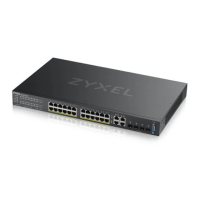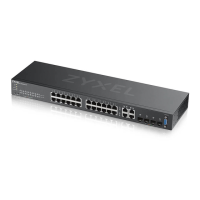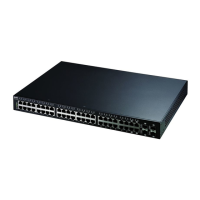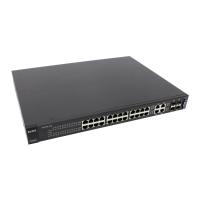GS2220 Series User’s Guide
133
C HAPTER 9
VLAN
9.1 O ve rvie w
This chapter shows you how to configure 802.1Q tagged and port-based VLANs.
The type of screen you see here depends on the VLAN Type you selected in the Switc h Se tup screen.
Note: If you have enabled CLV mode in the Command Line Interface (CLI) to configure the
Switch's VLAN settings, further VLAN changes you make through the Web Configurator
will not be saved and applied completely. You can still use the Web Configurator to
view the VLAN status.
If you want to configure VLAN settings in both the Web Configurator and the CLI, just
return to Zyxel configuration mode by turning off CLV mode. See the CLI Reference
Guide for more information about CLV mode.
9.1.1 Wha t Yo u Ca n Do
• Use the VLAN screen (
Section 9.3 on page 137) to view and search all static VLAN groups.
• Use the VLAN De ta il screen (
Section 9.3.1 on page 138) to view detailed port settings and status of the
static VLAN group.
• Use the Sta tic VLAN Se tup screen (Section 9.5 on page 139) to configure a static VLAN for the Switch.
• Use the VLAN Po rt Se tup screen (
Section 9.6 on page 141) to configure the static VLAN (IEEE 802.1Q)
settings on a port.
• Use the Subne t Ba se d VLAN Se tup screen (Section 9.7 on page 142) to set up VLANs that allow you to
group traffic into logical VLANs based on the source IP subnet you specify.
• Use the Pro to c o l Ba se d VLAN Se tup screen (Section 9.8 on page 145) to set up VLANs that allow you
to group traffic into logical VLANs based on the protocol you specify.
• Use the Voic e VLAN Se tup screen (Section 9.9 on page 147) to set up VLANs that allow you to group
voice traffic with defined priority and enable the Switch port to carry the voice traffic separately from
data traffic to ensure the sound quality does NOT deteriorate.
• Use the MAC Ba se d VLAN Se tup screen (
Section 9.10 on page 148) to set up VLANs that allow you to
group untagged packets into logical VLANs based on the source MAC address of the packet. This
eliminates the need to reconfigure the Switch when you change ports. The Switch will forward the
packets based on the source MAC address you set up previously.
• Use the Ve ndo r ID Ba se d VLAN Se tup screen (
Section 9.11 on page 149) to set up VLANs that allow
you to group untagged packets into logical VLANs based on the source MAC address of the packet.
You can specify a mask for the MAC address to create a MAC address filter and enter a weight to set
the VLAN rule’s priority.
• Use the Po rt- Ba se d VLAN Se tup screen (
Section 9.12 on page 151) to set up VLANs where the packet
forwarding decision is based on the destination MAC address and its associated port.

